MTG Arena: State of the Game – Alchemy
Begin Anew
This December, MTG Arena will launch a new digital-first format called Alchemy, a new play blade, our first Draft Arena Open, and more. There's a lot to go over here, so let's dive right in.
Alchemy
Alchemy is a new digital-only format that will be debuting in MTG Arena with our release on December 9. It uses the card pool of Standard as a base, but it extends that by adding rebalanced cards and digital-only cards.
Alchemy is launching with eleven rebalanced cards from the current Standard and the Alchemy: Innistrad supplemental set, which adds around 60 totally new cards with mechanics that could only work well in digital Magic.
We'll spell out everything you need to know about the new format below, and you can check out this morning's Weekly MTG (December 2) with Dave Humpherys and Ian Adams, two designers who worked on creating these new cards, for even more info.
Origins of Alchemy
Introducing a new format like this is a big change, and it's one we've been thinking and working on for some time now. For the last several years, players have been coming to MTG Arena for fast, fun digital Magic, and the play rate has been intense—each day, we see millions of matches of Magic on MTG Arena.
One of the key things we've learned from watching all of this play is that digital-first Magic players engage with the game slightly differently than tabletop players do. This is the same pattern we see across Magic play, and one of the main ways Magic has grown over the last several years is by embracing the many different ways that players love to play the game. From Commander players to collectors, from Standard and Modern to Pioneer, Historic, and beyond, we're working to create more products built for how every group likes to play and engage with Magic.
Alchemy is built for our digital-first players, who consume content more quickly but also want a metagame that stays fresh and evolves. As a digital-only format, Alchemy lets us add new cards after a set release, offer new mechanics that can only work in a digital game, and rebalance cards to keep the environment interesting and engaging every time players sit down to play.
We recognize that some players value a more authentic tabletop experience, so we want to reassure those players that Standard isn't going anywhere. Nothing about the addition of Alchemy will change how Standard currently works on MTG Arena, and we will continue to support formats that work just like the printed, tabletop version of the game.
Alchemy is simply an additional way to play, offering another option for players who want a new metagame and new strategies to conquer, who want a faster rate of evolution and change in that metagame, and who want a format that can work like a digital game.
Alchemical Components
Alchemy begins with all the cards in the Standard card pool and rotates on the same cadence, and then it adds in new features with rebalanced cards and cards with digital-only mechanics from supplemental sets like Alchemy: Innistrad. It also brings a new approach to digital-only formats across MTG Arena. We think these new features will help us keep digital formats fair and fun, so the rebalanced cards and new cards in Alchemy: Innistrad will also be legal in Historic, Historic Brawl, and similar digital-only formats.
Non-digital formats, like Standard and the Limited formats for any Standard sets, will not change at all in this process. They will continue to use the normal, printed versions of each card, and the cards from Alchemy: Innistrad will not be legal there.
Rebalanced Cards
In October's Banned & Restricted announcement, we rebalanced several digital-only cards from Jumpstart: Historic Horizons. Alchemy builds on this and extends it, creating a format where we can rebalance cards that have printed equivalents as well. Some of these are nerfs, bringing cards that had an outsized impact on the metagame back into the intended balance—still strong, but no longer dominating the field. Some of these are buffs, making cards that we've seen players enjoy, but fell short on power level, a bit stronger.
Here are some examples:
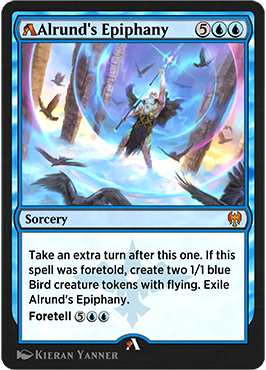
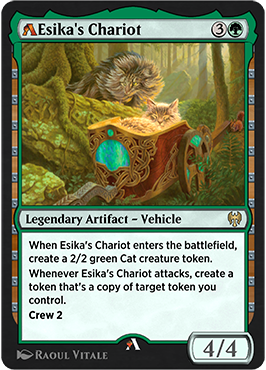
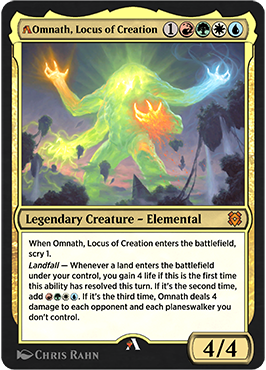
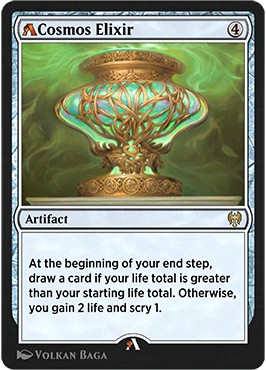
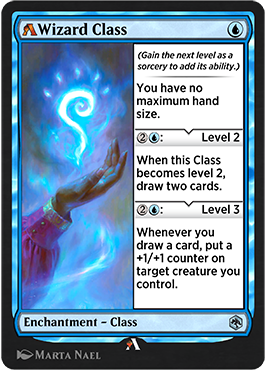
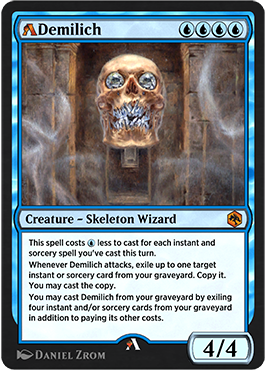
This rebalanced version of Omnath, Locus of Creation is legal in Alchemy, Historic, and other digital-only formats (the original remains banned in Standard). In general, we will look to rebalance rather than ban in Alchemy wherever we can. For a full list, as well as more details on rebalancing philosophy and why these cards and changes were selected, see Donald Smith's article.
As we saw recently in Historic, when digital-only cards are rebalanced, we can simply adjust the text on the existing card to update them. Things work slightly differently when we're rebalancing cards that have printed versions as well.
Since we want to keep Standard working exactly as it does in the tabletop version of Magic, we will not change any of these cards directly. Instead, whenever we need to rebalance a card that has a printed version, we will create a new, digital-only version of that card.
As shown above, these cards all display the MTG Arena "A" icon in their title bar to clearly call out that they are the rebalanced versions. Internally, their name is slightly different as well, with an "A-" prefix to indicate that they are the rebalanced version. For example, A-Esika's Chariot is the rebalanced version of Esika's Chariot. This only really matters for things like deck import and export, though; name-a-card effects and other in-game mechanics still refer to the normal name, for instance.
Since these rebalanced versions are now digital-only cards, any future balance adjustments can be applied directly. Starting with this update, all digital-only cards on MTG Arena will have the MTG Arena "A" down where the holofoil rarity stamp usually is so they can be clearly identified.
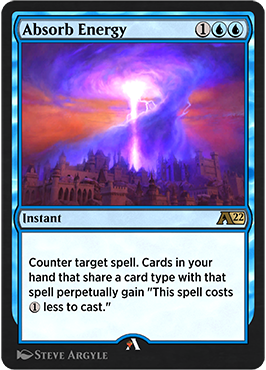
Whenever we create these rebalanced versions of cards, we will grant all players a number of rebalanced cards equal to the normal versions they have collected. If you have three copies of Esika's Chariot, you will also receive three copies of A-Esika's Chariot. After that, whenever a player collects one version of a rebalanced card, they will also receive the other version as well. This applies in all circumstances, whether receiving the card from a store pack, individual card reward, wildcard crafting, from a Limited pool, or any other way. It's all built to make it as easy as possible for players to go back and forth between Standard and Alchemy however they like.
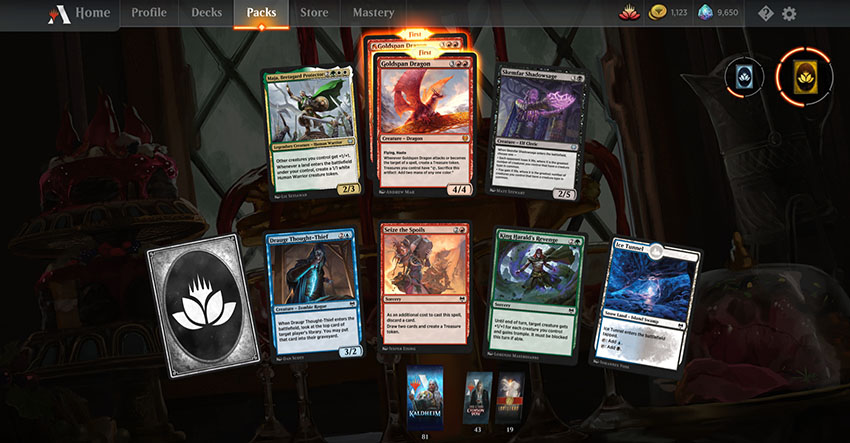
Going forward, we will regularly evaluate the Alchemy metagame and release additional balance adjustments to keep things diverse, fair, and fun. Since all of these rebalanced cards are now digital only, they will only be used in digital-only formats like Alchemy and Historic. Formats that are also played in tabletop Magic, like Constructed Standard or Limited formats with Standard sets, will continue to use the normal, printed versions of these cards.
Alchemy: Innistrad
In addition to the rebalanced cards, Alchemy also includes around 60 new cards found in Alchemy: Innistrad, a digital-only supplemental set featuring new cards and many new mechanics. Most of these cards are set on Innistrad, where fans will see some familiar characters, and a few of them call back to earlier sets in the current rotation.
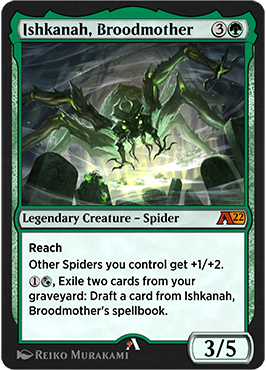
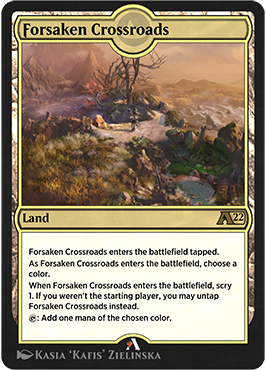
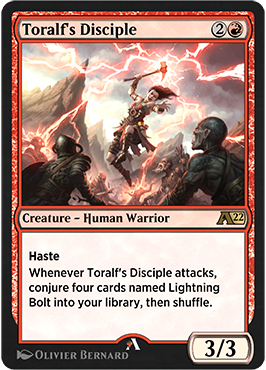
Drafting a card from a spellbook is one of the new mechanics in this set, and it works much like Davriel, Soul Broker's offers and conditions. You will see three cards chosen from among a curated list and select one, usually to put into your hand. Unsurprisingly, the spellbook for Ishkanah, Broodmother is full of spiders. You'll be able to browse through these spellbooks in game by right-clicking (or long-pressing) on the cards, much like looking at dungeons or cards that make multiple tokens.
We'll be previewing more cards from Alchemy: Innistrad throughout the week, so keep an eye on the forthcoming image gallery to see all the new cards and mechanics as they are revealed. We'll also be back a bit later in the week with an article from Magic Design about some of the philosophy and choices behind these new cards.
All of these cards can be found in the new Alchemy: Innistrad packs, which you'll find in the MTG Arena Store alongside packs for Innistrad: Crimson Vow:
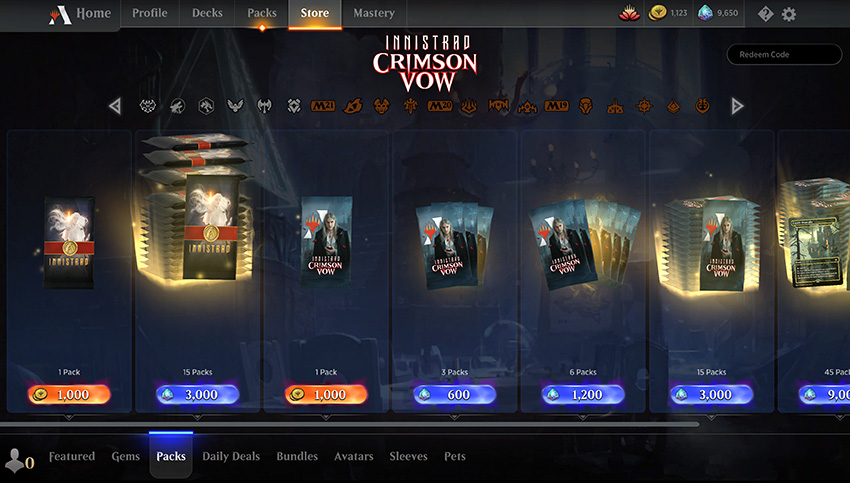
These packs work just like normal store packs, but because Alchemy: Innistrad doesn't have any commons, those slots are filled with Innistrad: Crimson Vow commons. Duplicate protection has been extended a bit in these packs as well; once you have collected a playset of all rare cards in Alchemy: Innistrad, the rare slot will provide uncollected Innistrad: Crimson Vow rares. Once you've collected four copies of all rares for Innistrad: Crimson Vow, you'll receive 20 gems as usual. This process applies to mythic rares as well; once you have complete play sets of Alchemy: Innistrad mythic rares, you'll receive Innistrad: Crimson Vow mythic rares and then 40 gems.
Going forward, each Standard set will have a supplemental Alchemy set of around 30 cards that will be available about a month after the main set releases. These cards will all rotate out of Alchemy with the set they are based on, though after rotation, they will continue to be playable in Historic.
Playing Alchemy
With our December update, Alchemy joins Standard and Historic as one of the main formats on MTG Arena. It will offer all the same queue options, like ranked and unranked or Best-of-One and Best-of-Three, and it will also be used in a variety of events. Ranked play in Constructed Alchemy increases the same Constructed rank used in Standard and Historic, so players are able to move between different formats without hurting their ranked progress.
Any Standard deck that doesn't use the rebalanced cards is ready to go for Alchemy, and any deck using the rebalanced cards will just need to swap in the new, rebalanced versions that players have been granted. But to really experience Alchemy, you'll want to include some of the new cards as well. To help every player get this experience, and to celebrate the launch of Alchemy, when you login after the update, you will receive three Alchemy: Innistrad packs and several rare (or better) individual card rewards.
As a main format, we will also be supporting Alchemy with competitive events—the Qualifier Weekend from the December ranked season will use Alchemy, and there will be an Alchemy Arena Open in January. We will continue offering competitive events in Standard and Historic as well, but Alchemy will regularly be part of the mix.
Alchemy brings a whole new way to play Magic to MTG Arena, and it gives us a format where we can use digital tools to create a more robust and varied environment for our digital-focused players. We will continue to support traditional tabletop-style play the same as we always have, because we know there are a large number of players who value that style of play. But we also know that there are players looking for more variety and challenge, for a format where balance problems can be swiftly corrected without needing to ban cards or eliminate whole decks, and now they will have a format built for them.
Play Blade Update
With the addition of all the new queues and events for Alchemy, we wanted to update our "play" menu to allow players to find the mode they are looking for more easily among all the new options. The existing play menu (which we sometimes refer to as the "play blade") is functional, but the lists of queues and events can turn into a "wall of text" that is hard to parse.
With this release, it will get a long-awaited makeover. This has been in the works for quite some time, and we're very happy to finally start rolling it out.
Let's walk through the new features and flow:
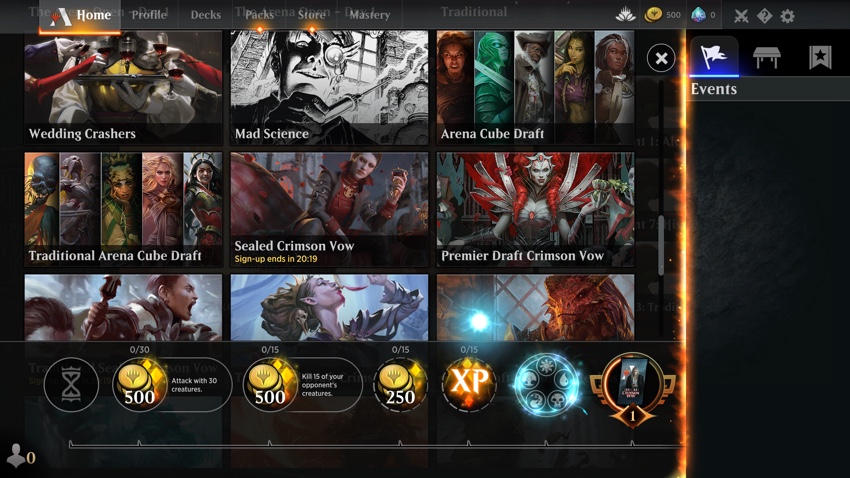
Under the flag icon, the Events tab now shows visual panels for each event, and any events you are actively playing will automatically display at the top.

Under the table icon, the Find Match tab lets you easily find the Constructed match you're looking for. Select ranked, unranked, or Brawl via the tabs, adjust Best-of-One or Best-of-Three, and choose the format you want. These are all the same options and queues as before (plus the additions from this update), but now rearranged for easier access.
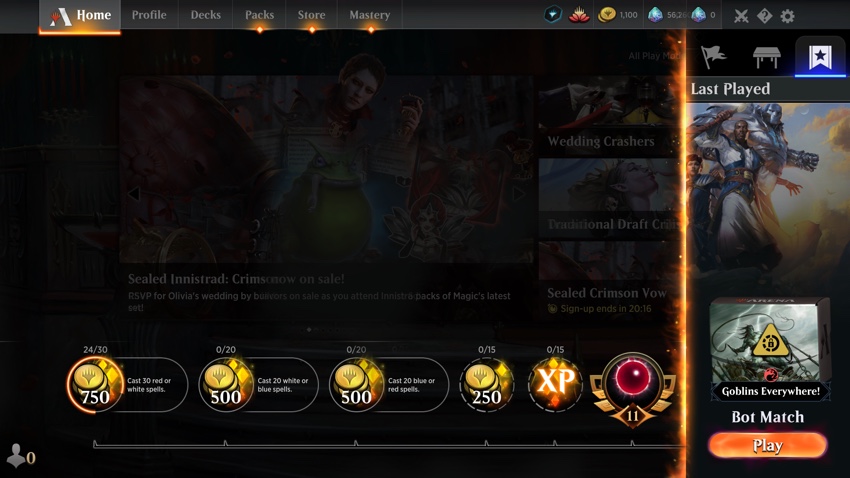
Finally, under the bookmark icon, the Last Played tab will let you requeue in an instant for the mode you last played.
This new play blade gives us more room to lay out and explain all of the play options available to players. Now that we have this version out, we will also be able to continue iterating on it, with some improvements already in the works there.
Rounding things out
The new play blade and Alchemy format are large changes, but they're not all that's new in MTG Arena. Coming up this weekend, we have our first-ever Draft Arena Open, and we have a couple smaller changes as well with tokens for Jump In! added to the Color Challenge and the addition of unranked Best-of-Three Historic.
Draft Open
The Arena Open is coming up this weekend (December 4–5), and it will be Innistrad: Crimson Vow Player Draft! We know this has been a highly desired feature, and we're just as happy as you are to be bringing players competitive Limited play on MTG Arena.
As you've probably seen, player names at Innistrad: Crimson Vow draft tables have been hidden so that we can accommodate Arena Open drafters. Player names in the Premier Draft queue will be restored with this upcoming release but will remain hidden in Traditional for use in the December 18 Qualifier Weekend. We are still developing this process, and there will be further improvements here to keep identity hidden in high-stakes events while allowing the fun of seeing who you're drafting with outside of them.
Jump In! Tokens in Color Challenge
Over the past months, Jump In! has been a great addition to MTG Arena, especially as a place for new players to get their first taste of a Limited-style mode, build their collections, and see more of the strategies that Magic has to offer.
With this update, we are building it into the Color Challenges as well. New players will now get several Jump In! tokens after completing the fourth Color Challenge in which events are unlocked to help them continue learning about the game.
Players with tokens will see Jump In! at the top of the event listing on the Home page, and Sparky will help direct new players there. We think this is a great mode for players new and experienced alike, so we will continue to support Jump In! with new packets alongside each major set. The next round of new packets will be coming with Kamigawa: Neon Dynasty next year.
Unranked Historic Best-of-Three
Finally, we are going to be trying out offering Unranked Historic Best-of-Three. We've resisted this in the past out of concerns about queue health and especially the quit rate in an unranked Best-of-Three format, but we want to see how these issues play out in practice. We'll be monitoring matchmaking health and how many matches get to two wins to ensure the queue is providing a good experience for players.
Cleanup Step
There's a lot that's new in this update, and we're very happy to finally be able to bring these changes out to players. We have more new things on deck as well, and we'll be back with another State of the Game ahead of Kamigawa: Neon Dynasty next year to talk more about those. Until then, keep an eye on our weekly announcements to stay up to date with what's coming to MTG Arena.
